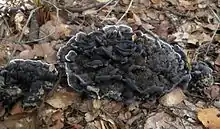Phellodon sinclairii
Phellodon sinclairii is a native tooth fungus found in beech forests of New Zealand. It was first described by Miles Joseph Berkeley in 1867 as a species of Hydnum in Joseph Dalton Hooker's work Handbook of the New Zealand Flora.[2] The type locality was on Maungatua. Gordon Herriot Cunningham transferred the species to the genus Phellodon in 1958.[3]
| Phellodon sinclairii | |
|---|---|
 | |
| Scientific classification | |
| Kingdom: | |
| Division: | |
| Class: | |
| Order: | |
| Family: | |
| Genus: | |
| Species: | P. sinclairii |
| Binomial name | |
| Phellodon sinclairii | |
| Synonyms[1] | |
| |
The fruit bodies of P. sinclairii have caps up to 3 cm (1.2 in) in diameter when single, or up to 7 cm (2.8 in) when the caps are fused together in groups. The cap surface is black with a whitish margin. The crowded spines on the cap underside are up to 2 mm long, and run decurrently down the stipe. Initially whitish, they become gray in age. Dried specimens have the odour of fenugreek.[4]
References
- "GSD Species Synonymy: Phellodon sinclairii (Berk.) G. Cunn". Species Fungorum. CAB International. Retrieved 2016-02-03.
- Hooker JD. (1867). "Handbook of the New Zealand Flora. Part II". London UK: Reeve & Company: 756. Cite journal requires
|journal=(help) - Cunningham GH. (1958). "Hydnaceae of New Zealand. Part I. The pileate genera Beenakia, Dentinum, Hericium, Hydnum, Phellodon and Steccerinum". Transactions and Proceedings of the Royal Society of New Zealand. 85 (4): 585–601.
- Maas Geesteranus RA. (1971). "Hydnaceous fungi of the eastern old world". Verhandelingen Koninklijke Nederlandse Akademie van Wetenschappen Afdeling Natuurkunde. 60 (3): 1–176 (see p. 40).
This article is issued from Wikipedia. The text is licensed under Creative Commons - Attribution - Sharealike. Additional terms may apply for the media files.